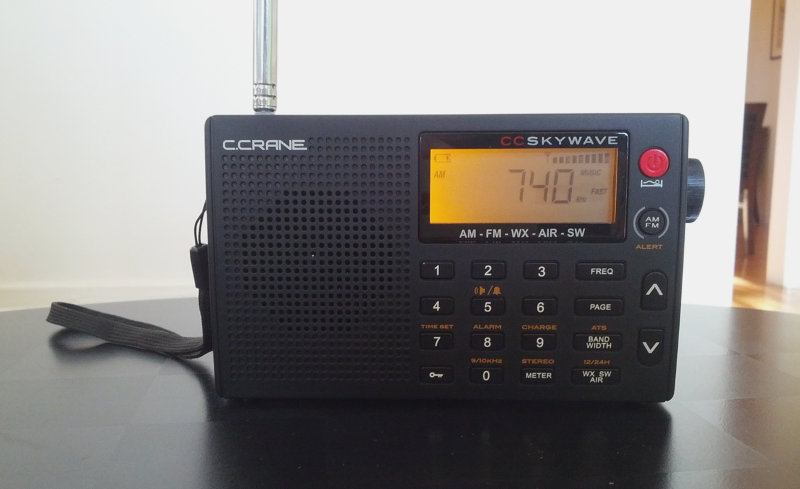
Even though the chips used in DSP radios come from the United States, Chinese brands have dominated the field since the first modestly priced DSP radios came out in 2008. The American specialty retailer and designer C. Crane started making inroads in 2012 with the CC Pocket radio, tailored to the needs of the American market. In November 2014, C. Crane released another model, the CC Skywave, aimed at the market for radios suitable for travel. As such, its closest equivalents among the Chinese brands originally were the Tecsun PL-310ET and the Tecsun PL-380.
The CC Skywave is actually smaller than those Tecsun models, though the Tecsun radios are a little thinner. It's closer in size to the Tecsun PL-505 and PL-606.
After this review was originally written, additional models have come out from other brands. They're nearly the same size as the CC Skywave, with many of the same features as well, leading some observers to conclude that they're copycats.
The Radiwow R-108 was the best-known such radio after its release in late 2018. Other similar models are the Digitech AR-1733, sold in Australia and New Zealand; and the Elpa ER-C57WR, sold in Japan.
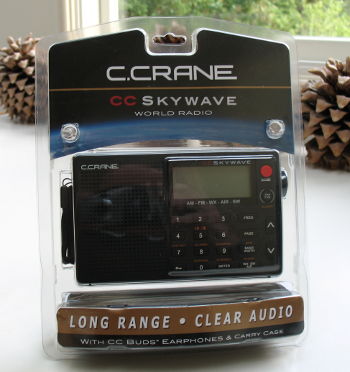 The CC Skywave is compact: 4 3/4" wide by 3" high and a bit more than an inch
in depth. It even comes in a smaller package than the CC Pocket, which is
actually smaller than the CC Skywave. Included are earbuds and a flexible
plastic-covered cloth case that fits the radio snugly.
The CC Skywave is compact: 4 3/4" wide by 3" high and a bit more than an inch
in depth. It even comes in a smaller package than the CC Pocket, which is
actually smaller than the CC Skywave. Included are earbuds and a flexible
plastic-covered cloth case that fits the radio snugly.
Unique among DSP radios in this category, the Skywave incorporates both the weather band used in the United States and Canada, and the international aviation band. Unlike the Tecsun radios, longwave coverage is not included.
In November 2017, the CC Skywave SSB radio was introduced, at a higher price. It introduces the ability to listen to AM broadcasts on both mediumwave (what North Americans call "AM") and shortwave in a single-sideband mode. Wikipedia has a detailed explanation of SSB reception. Initial reviews of the CC Skywave SSB indicated that its performance on all bands is nearly identical to the CC Skywave.
The CC Skywave is a very good to excellent performer, with better audio than the Tecsun or Degen DSP radios that I've had, but using it can be an occasionally confusing experience. It's essential to read the operating manual. Some functions are obscure and the uninformed user may be surprised by the radio's behavior in certain circumstances. Even so, this has become my go-to radio for travel. Compared to the Tecsun radio, it seems a little sturdier, the audio quality is better, and many of the controls are relatively easy to deal with once you've had the radio for a short while. This review will be longer than most of my other reviews in order to describe some of the quirks of the CC Skywave.
For instance, there's a numeric keypad but it's used to select memory presets. To directly enter the frequency of the station you want, you first press the FREQ button and then enter the frequency. Other radios I've had will allow direct frequency entry from the numeric keypad.
Here's another example of how this radio behaves differently from Tecsun radios. While the radio is off, you have to set the default audio bandwidth for AM and shortwave listening through the BANDWIDTH button on the front panel. Five bandwidths are available to balance selectivity and audio quality: 6, 4, 3, 2, or 1 kHz. The operation manual says the original default bandwidth setting is 3 kHz, but it was 4 kHz on the radio that I received. This would have been my preferred setting anyway.
So far, so good. However:
- If you change the bandwidth while listening to a station, and then tune to another station, the bandwidth will change back to the default setting that you had set with the radio off.
- The bandwidth setting for a station that you stored in memory will also be stored along the frequency. When you recall that station, the bandwidth setting with change, too, just for that station.
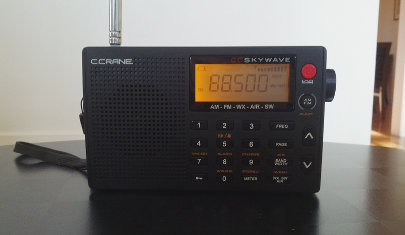
On FM, I occasionally had some difficulty ensuring that stereo reception was the default. It is clear that the mono/stereo status of a station will be stored in memory along with its frequency. In other words, if you were listening to a stereo station in mono when you stored it in memory, recalling the station will bring back the station in mono.
The manual says, "In the FM band the METER/STEREO button will cycle between stereo and mono FM reception." However, I found that this wasn't always the case, particularly after listening to a station that had originally been stored while listening in mono. Listening to other stations would be in mono, too, until pressing the METER/STEREO button.
There is also a "voice" audio filter that C. Crane claims improves the intelligibility of voice broadcasts. It seems to be similar to a treble cut switch. It's most suitable for listening through the speaker. In my perception, when used while listening with headphones, the voice filter actually makes makes the broadcast less intelligible.
Similar to the Radiwow R-108, this filter functions somewhat like, but not exactly like, a high-cut tone control. The graphs below (music setting at left, voice setting at right) were taken with a sweep tone feeding an FM signal to avoid any effects from the AM or shortwave bandwidth selections. Comparing the frequency response curves between the two positions indicates that frequency response in the voice position starts down 2 dB at 1 kHz, then 4 dB at 2 kHz, 6 dB at 4 kHz, and 7 dB at 6 kHz, leveling out from that point through the rest of the audio spectrum (up to 15 kHz in the case of FM). This is slightly more equalization than on the Radiwow R-108. There also appears to be a rolloff of low-frequency response with the CC Skywave's voice setting, down 3 dB at 100 Hz.
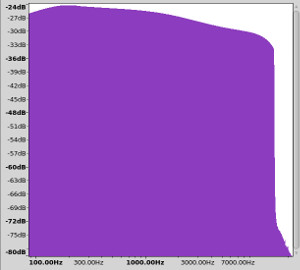
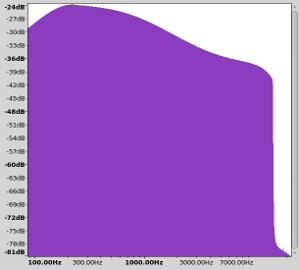
On earlier versions of the CC Skywave, such as the one that I have, setting the voice filter requires pressing "1" and "2" at the same time. This is not labeled anywhere on the radio. For the weather and aviation bands, the voice filter is the only choice, which makes a lot of sense for those applications.
On newer models, according to the online version of the CC Skywave manual, the voice filter is toggled with a long press of the PAGE button. This is labeled on the radio. The same method is now used on the CC Skywave SSB radio as well.
Two other settings that I made sure to change before using the CC Skywave:
- Turning off all beeps by pressing "3" with the radio off (use a long press of two seconds or more).
- Changing the default display from the clock to the frequency of the station to which the radio is tuned - press "4" with the radio off (use a long press as well). When the default display is set to the station frequency, you can view the clock momentarily by pressing the lock button (the one with the icon of a key).
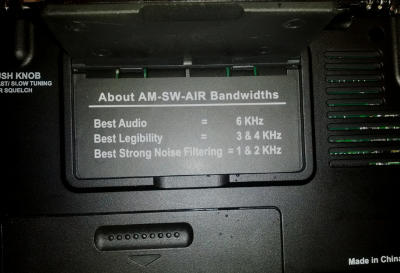
There could have been a reminder of these obscure functions printed on the radio, similar to the helpful list printed on the battery compartment door of the CC Pocket. Instead space was used for a pointless listing of audio bandwidths available on the radio, easily accessed with the BANDWIDTH button on the front panel.
One more quirk: to set the alarm, you have to set the time of the alarm first, though this can be bypassed with a couple of presses to the ALARM button (the "8" button with the radio off, but this is labeled).
The radio has 100 memories, divided into 10 pages. Memories and pages are numbered from zero to nine (though page zero comes last). There is no equivalent of Tecsun's Easy Tuning Mode (ETM), which a second memory store that doesn't disturb the original memory settings. One can achieve the same effect by storing one's preferred stations starting with page 5 or page 6, and then using the ATS function to populate the lower-numbered pages, starting with page 1. For example, when I used ATS at my Bay Area location, 45 FM stations were stored in memory. Unlike the Tecsun radios I've had, the CC Skywave correctly ignored digital sidebands and did not store any false signals after a scan.
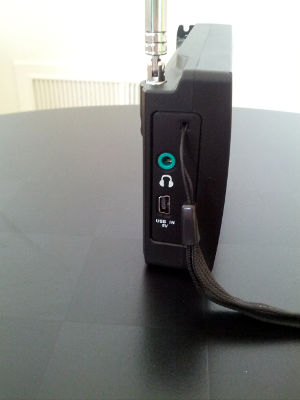
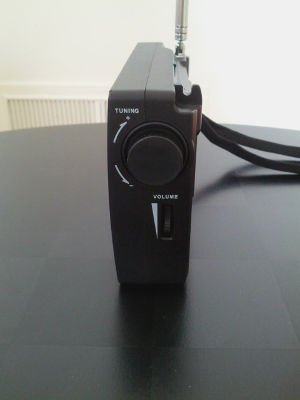
Tuning among stations can be done three ways: through the knob on the side of the radio, through up-and-down buttons on the front panel, or by pressing the FREQ button and directly entering the frequency. The volume control is an analog control without detents. Detented controls have been a problem for some Tecsun models, and their step-by-step volume controls seem to be particularly disliked. That's not a problem with the CC Skywave.
The headphone jack automatically shuts off the small built-in speaker, unlike the CC Pocket. There is a USB port for powering and charging the radio. The radio does not come with rechargable batteries and, if rechargable batteries are used, they must be nickel-metal hydride (NiMH). Two AA batteries are required.
None of the operational quirks I've described take away from the performance of the radio. I was curious to see how it performed compared to the similarly-sized Tecsun PL-380 and compared to the CC Pocket.
The question of performance brings up the one serious complaint I have about the CC Skywave: the antenna is the wrong length for FM reception. The rod should be 30 inches long. Instead, it's 19 1/2" inches long. In the following comparisons, I also used an antenna extender to attempt to get the Skywave's antenna length to the correct 30 inches.
Even with that, I found the Skywave's AM and FM performance to be nearly identical to the CC Pocket: excellent on FM, very good on AM. Using station counts as my metric, here was what I found on one chilly, windy December day at high noon:
CC Pocket - 46 AM stations, 48 FM stations.
CC Skywave - 46 AM stations, 49 FM stations; 51 FM stations with antenna extender
Tecsun PL-380 - 46 AM stations, 52 FM stations (21" antenna length)
In my review of the Tecsun PL-310ET, I did another head-to-head comparison, and found that the CC Skywave received one less station than the PL-310ET and two fewer stations than the PL-380. While this is not a major difference, and the stations in question were very weak, it reinforces my conclusion that the too-short length of the CC Skywave's antenna is a detriment to its performance. There is no jack for an external FM antenna; an antenna extender is the best solution to get the correct length for FM reception. If C. Crane can't get a longer antenna for the radio, they should consider including an extender with the package.
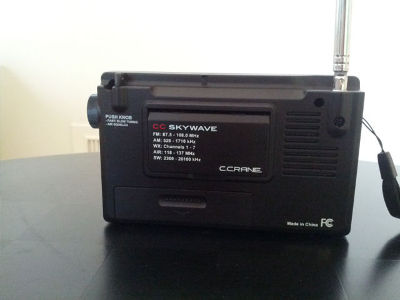
The improperly sized FM antenna also caused very weakest stations to be weaker than they otherwise would have been. They wouldn't have been received in stereo in any event, but when I used the antenna extender, I could pull them out of the noise.
More recently in 2019, I have conducted several other head-to-head comparisons of FM reception, and have found that, while the CC Skywave is excellent, the Radiwow R-108 is just slightly better and Tecsun radios are a tiny bit better even still. Those other radios might pull in one or two very weak stations that the CC Skywave might miss. Regardless, the CC Skywave, as with most other DSP-based radios, represents a big advance for reception of weak FM signals. As low-power FM stations and translators proliferate, I expect this level of capability to become important to more than just hobbyist listeners.
The AM performance of the CC Skywave was better than the Tecsun PL-380 in a couple of other aspects. There were many fewer digital noises, such as beeps or tones, on the CC Skywave. Audio recovery through the automatic gain control was just a little stronger and more consistent on the CC Skywave.
The audio quality of the CC Skywave was just a little better, too, both with headphones and through the 1 1/2"-diameter speaker -- there was a little more bass and a little more presence. The analog volume control also provided better control over listening volume. There wasn't an abrupt jump between levels as there sometimes can be with the Tecsun radios.
I paid $90 for the radio plus shipping, for a total of just over $100. Comparable Tecsun radios in December 2014 went for roughly half that amount. There is extra value with the CC Skywave: the weather band coverage is especially useful but, for some, coverage of the aviation band may be worthwhile, too. You are getting access to customer service based in California rather than the Far East. The audio quality is better, too, and AM reception is more refined than on the Tecsun DSP radios.
It's fair to say that I could devote so much of this review to some of the odd attributes of the CC Skywave just because it has the kind of performance at a reasonable price that one could only have dreamed about even 15 years ago.
If C. Crane gets the antenna length right for FM reception, they'll have an awesome little radio, especially worthy of consideration as a travel companion.